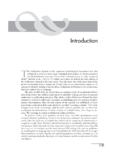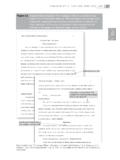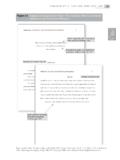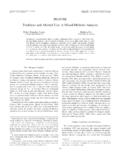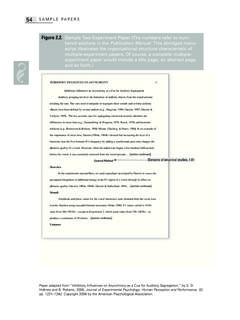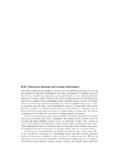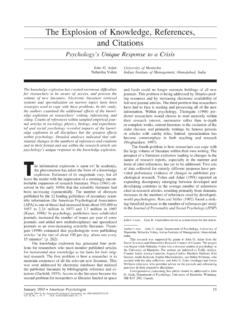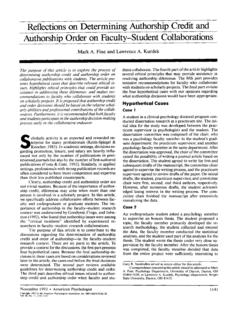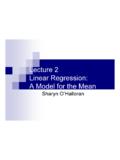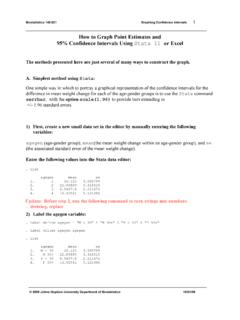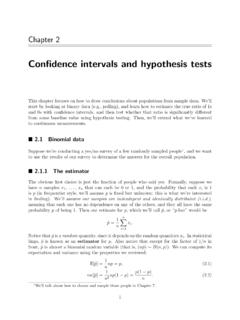Transcription of Inference by Eye - APA Style
1 Inference by Eye Confidence Intervals and How to Read Pictures of Data Geoff Cumming and Sue Finch La Trobe University Wider use in psychology of confidence intervals (CIs), ogy and some other disciplines have important misconcep- especially as error bars in figures, is a desirable develop- tions about CIs. Second, there are few accepted guidelines ment. However, psychologists seldom use CIs and may not as to how CIs should be represented or discussed. For understand them well. The authors discuss the interpreta- example, the Publication Manual (APA, 2001) gives no tion of figures with error bars and analyze the relationship examples of CI use and no advice on Style for reporting CIs between CIs and statistical significance testing.
2 They pro- (Fidler, 2002). pose 7 rules of eye to guide the inferential use of figures Four main sections follow. In the first, we discuss with error bars. These include general principles: Seek basic issues about CIs and their advantages. The second bars that relate directly to effects of interest, be sensitive to presents our rules of eye for the interpretation of simple experimental design, and interpret the intervals. They also figures showing means and CIs. Our main focus is CIs, but include guidelines for inferential interpretation of the over- in the third section we discuss standard error (SE) bars.
3 We lap of CIs on independent group means. Wider use of close with comments about some outstanding issues. interval estimation in psychology has the potential to im- prove research communication substantially. CIs and Error Bars: Basic Issues What Is a CI? I nference by eye is the interpretation of graphically presented data. On first seeing Figure 1, what questions should spring to mind and what inferences are justified? We discuss figures with means and confidence intervals (CIs), and propose rules of eye to guide the interpretation of Suppose we wish to estimate the verbal ability of children in Melbourne, Australia.
4 We choose a recognized test of verbal ability and are willing to assume its scores are normally distributed in a reference population of children. We test a random sample of Melbourne children (n 36). such figures. We believe it is timely to consider Inference and find the sample mean (M) is 62 and the sample standard by eye because psychologists are now being encouraged to deviation (SD) is 30. Then M is our point estimate of the make greater use of CIs. population mean verbal ability of Melbourne children.
5 We Many who seek reform of psychologists' statistical seek also a 95% CI, which is an interval estimate that practices advocate a change in emphasis from null hypoth- indicates the precision, or likely accuracy, of our point esis significance testing (NHST) to CIs, among other tech- estimate. The 95% is the confidence level, or C, of our CI, niques (Cohen, 1994; Finch, Thomason, & Cumming, 2002; Nickerson, 2000). The American Psychological As- and we are following convention by choosing C 95. The sociation's (APA) Task Force on Statistical Inference CI will be a range centered on M, and extending a distance (TFSI) supported use of CIs (Wilkinson & TFSI, p.)
6 599), w either side of M, where w (for width) is called the margin and the APA Publication Manual states that CIs are, in of error. The margin of error is based on the SE, which is general, the best reporting strategy (APA, 2001, p. 22). a function of SD and n. In fact, SE SD/ n 30/ 36 . Statistical reformers also encourage use of visual rep- 5, and w is the SE multiplied by t(n 1),C, which is a critical resentations that make clear what data have to say. Figures can convey at a quick glance an overall pattern of results Geoff Cumming and Sue Finch, School of Psychological Science, La (APA, 2001, p.
7 176). The TFSI brought together advocacy Trobe University, Melbourne, Victoria, Australia. of CIs and visual representations by stating the following: This research was supported by the Australian Research Council. We In all figures, include graphical representations of interval thank Kevin Bird, Mark Burgman, Ross Day, Fiona Fidler, Ken Green- wood, Richard Huggins, Chris Pratt, Michael Smithson, Neil Thomason, estimates whenever possible (Wilkinson & TFSI, 1999, p. Bruce Thompson, Eleanor Wertheim, Sabine Wingenfeld, and Rory 601).
8 In other words, CIs should be displayed in figures. Wolfe for valuable comments and Rodney Carr for showing what Excel We applaud this recommendation and believe it has the can do. potential to enhance research communication in psychol- Correspondence concerning this article should be addressed to Geoff ogy. However, two difficulties are likely to hinder its Cumming, School of Psychological Science, La Trobe University, Mel- bourne, Victoria 3086, Australia, or to Sue Finch, who is now at the adoption.
9 First, according to evidence presented by Belia, Statistical Consulting Centre, University of Melbourne, Melbourne, Vic- Fidler, Williams, and Cumming (2004) and Cumming, toria 3010, Australia. E-mail: or @ms Williams, and Fidler (2004), many researchers in psychol- . 170 February March 2005 American Psychologist Copyright 2005 by the American Psychological Association 0003-066X/05/$ Vol. 60, No. 2, 170 180 DOI: captured by the central part of a CI than by either extreme. The occasional CI (two cases in Figure 2; 5% of cases in the long run) will not include.
10 Running an experiment is equivalent to choosing just one CI like those shown in Figure 2, and of course we do not know whether our interval does or does not capture . Our CI comes from an infinite sequence of potential CIs, 95% of which include , and in that sense there is a chance of .95 that our interval includes . However, probability statements about individ- ual CIs can so easily be misinterpreted that they are best avoided. Bear in mind Figure 2 and that our calculated CI. is just one like those illustrated.
